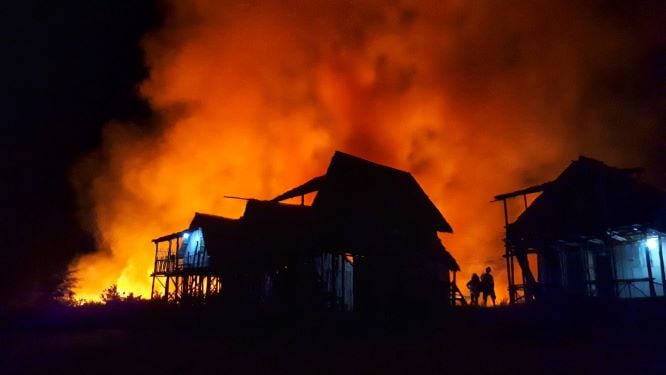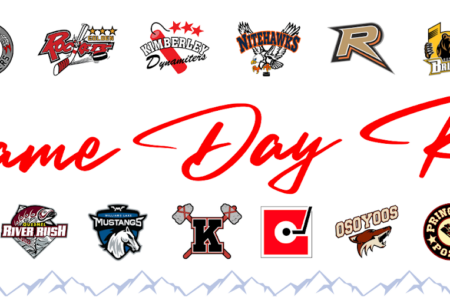Editorial: Burning Issues
“Everything will burn, baby, burn . . .”– if we don’t take a bit of time and effort to make it as fire-resistant as possible. These words from the 2001 song by Ash can remind us about the increasing risk of wildfire consuming forests, and overwhelming communities full of homes and businesses. Local wildfire expert Don Mortimer has given presentations locally to help people evaluate their homes and yards, and the Rossland Range Recreation Site cabins, and surrounding forested areas, and decide what steps will most help to reduce the risk of losing them to wildfire.
It’s worth taking the time and care to reduce the flammability of our homes and surroundings as best we can. It’s also worth taking the time and care to urge governments to take action to combat the climate crisis, as continuing “business as usual” that has caused the crisis — and so increased our risk of heat waves, drought and wildfire — will not improve our chances.
Meanwhile, think about how to make your home less likely to burn. Here’s an interesting fact: half the homes burned from wildfires are ignited from sparks and embers. Most of the homes that burn have not been made “FireSmart.”
What to do? Here’s are ten steps homeowners can take.
1. Keep the area around your home and other buildings clear of flammable plants, firewood, debris, long grass, or anything else that can burn. Don’t have shrubs or trees growing next to the building. Use metal gutters instead of plastic or wood, and keep your gutters cleaned out! Embers plus debris build-up in combustible gutters is a recipe for losing your home.
2. Don’t use bark mulch or other vegetation-based mulches next to your buildings. Instead, use rock or gravel mulch.
3. Keep a ten-metre (approximately thirty-three feet) distance between trees and your buildings. Also be sure that woodpiles and any propane tanks are at least ten metres from your home.
4. Replace conifers such as pines, fir, and spruce with less-flammable trees such as birch, maple, ash, cherry and aspen.
5. Assess the flammability of your home. If you have highly flammable siding or roofing, such as cedar shakes or shingles, it’s even more important to keep a clear zone around the buildings. If possible, replace highly flammable materials with fire-resistant materials such as masonry stucco, or cement board for siding; for roofs, fibreglass-asphalt composition shingles or another “Class A” rated material. For more details on assessing your home, go to: https://www.firesmartcanada.ca/mdocs-posts/firesmart-home-assessment/
6. Cover all vents or other openings – even tiny ones! – with 1/8” galvanized metal mesh. The metal mesh will prevent small animals such as mice and squirrels, or small birds, from getting in and bringing flammable nesting materials to create little piles of tinder in your building. The metal mesh will also prevent larger burning embers from blowing in and setting fire to those little piles of tinder – or the materials inside. Having Class A roofing material doesn’t do much good if there are little gaps between the roofing and the sheathing, or the roofing paper beneath the roofing, that embers can penetrate.
7. Use soffits to cover eaves, and make sure the vents are covered with 1/8” metal mesh. Exposed rafters catch fire much more quickly than rafters that are shielded by soffits – especially metal ones. If a fire threatens, homeowners can cover the soffit vents with metal or plywood strips, then remove them again when the threat has passed.
8. Be aware of where the breeze tends to blow leaves and other pieces of debris. If leaves (etc.) settle in any particular place, it’s likely that embers from nearby fires will also settle there. If there are little collections of dry leaves that can catch fire, they increase the fire hazard to your home. Try to keep little accumulations of wind-blown debris from building up; and try to make any areas where they do tend to collect as fire-resistant as possible.
9. Planning a deck? The most fire-resistant deck materials are light-weight concrete, or tile. If you have a deck with combustible deck boards, with spaces between them, take care to clean out the gaps where debris can accumulate and be ignited by embers. If a fire threatens, it’s worthwhile to remove a few of the deck boards closest to the wall of the home, and replace them later. It’s also worthwhile to make sure that the area below the deck is non-flammable – with no flammable items stored there.
10. Fences: If a fence or a gate is attached to a home, be sure it is made of non-combustible material – such as steel – and don’t allow long grass or other flammable material to collect along the fence, especially beside the building.
There is more useful information available at https://firesmartbc.ca/ about the combustibility of different materials, how some designs of fencing are more likely to burn than others, and many other topics of interest to those of us who don’t want our communities or our homes to burn.
Let’s make the effort to keep these words of that 2001 song from coming true for us:
“We are spiraling on the breeze
Almost to the point of no return
Everything will burn baby burn . . . ”


























